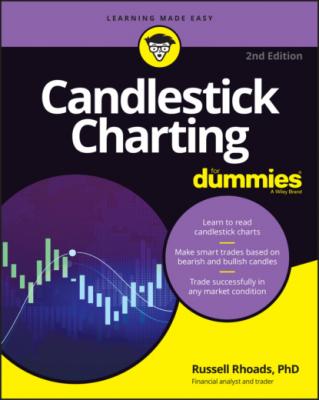ТОП просматриваемых книг сайта:
Candlestick Charting For Dummies. Russell Rhoads
Читать онлайн.Название Candlestick Charting For Dummies
Год выпуска 0
isbn 9781119869979
Автор произведения Russell Rhoads
Жанр Ценные бумаги, инвестиции
Издательство John Wiley & Sons Limited
258 263
259 264
260 265
261 266
262 267
263 268
264 269
265 270
266 271
267 272
268 273
269 274
270 275
271 276
272 277
273 278
274 279
275 280
276 281
277 282
278 283
279 284
280 285
281 286
282 287
283 288
284 289
285 291
286 292
287 293
288 294
289 295
290 296
291 297
292 298
293 299
294 300
295 301
296 302
297 303
298 304
299 305
300 306
301 307
302 308
303 309
304 310
305 311
306 312
307 313
308 315
309 316
310 317
311 318
312 319
313 320
314 321
315 322
316 323
317 324
318 325
319 326
320 327
321 328
322 329
323 330
324 331
325 332
326 333
327 334
Introduction
When I wrote the first version of this book, candlestick charts were a known method of displaying and analyzing price data but weren’t the default charting method for most traders. Now, more than ten years later, the charts shown in the business media are often candlestick charts. This situation is fully understandable, because candlestick charts are better visuals than line charts or bar charts. But even though candlestick charts are common nowadays, most traders still don’t understand candlestick patterns, much less use them in day-to-day trading.
After the first edition of this book was published, I received some criticism that I spent too much time discussing instances in which candlestick patterns didn’t work out. One of the top reasons why traders fail, however, is that they don’t take losses even when it makes sense. Whenever a trader enters a trade, they should have an exit plan that involves taking either losses or profits. This book sticks with the format of showing both profitable and losing trades for each pattern.
About This Book
This book isn’t intended to be an end-all-and-be-all guide to profitable trading. It’s meant to provide readers some insight into how candlesticks are created and how they can be used to analyze the psychology behind what happens over the course of trading days. (When I say psychology, I’m not trying to conjure up images of Freud and Rorschach tests; I’m talking about the motivating factors that determine how the market behaves.)
I made an effort to use as many examples as possible in the text, and every example comes from actual charts, showing you not only how common candlestick patterns are in everyday trading, but also how they’re used them in live trades. They’re waiting for you to harness their power!
Also, for each new candlestick pattern that I introduce, I present at least one case that produces a useful signal and one that produces a dud. Candlesticks are terrific, but they’re not perfect, and recognizing the failure of a signal is just as important as picking up on a valid signal.
I hope that the candlestick methods described in this book help you make trading and investment decisions that lead to solid profits, but unfortunately, I can’t guarantee those profits. What I can guarantee is that after reading this book, you’ll understand what candlesticks are, what they represent, and how to use them effectively in trading.
Foolish Assumptions
Knowledge of candlesticks varies widely from trader to trader. Even traders with the same amount of trading experience can differ quite a bit in their candlestick know-how. So I’ve made these assumptions about you:
You have at most a very basic understanding of what comprises a candlestick chart. (My apologies if you already know a little about candlesticks, but hey, it never hurts to review and hone essential candlestick skills.)
You have some sort of experience in trading a stock or at least a mutual fund.
You’ve spent some time looking over stock charts.
Icons Used in This Book
I used the following icons throughout the book to point out various types of information:

